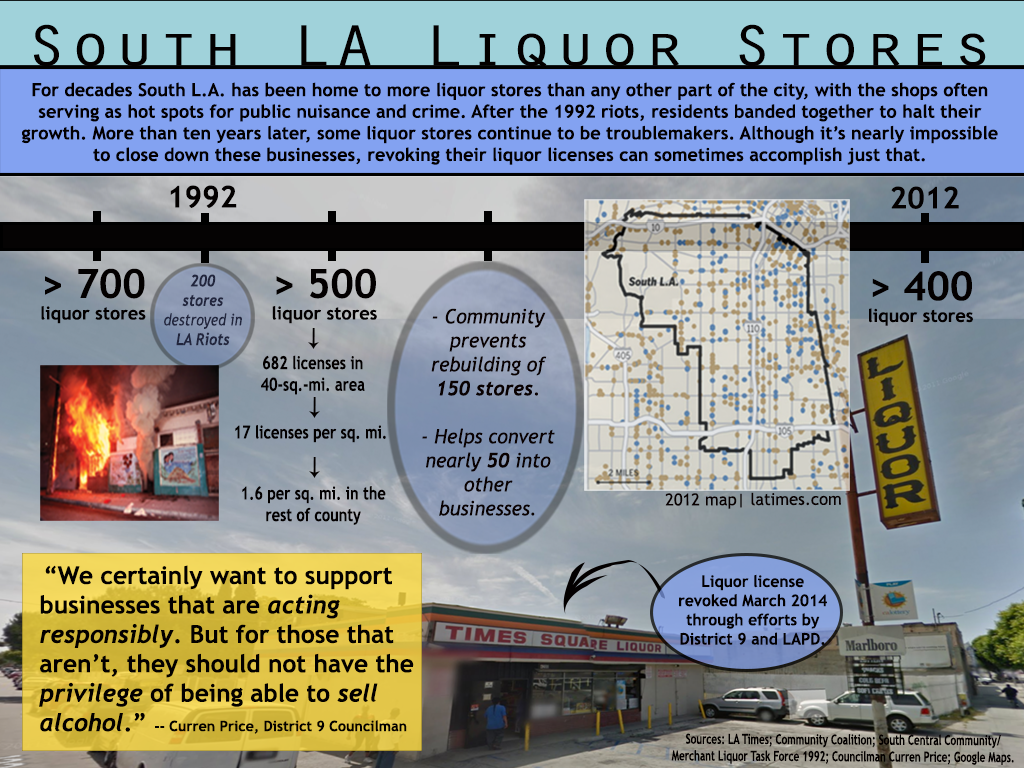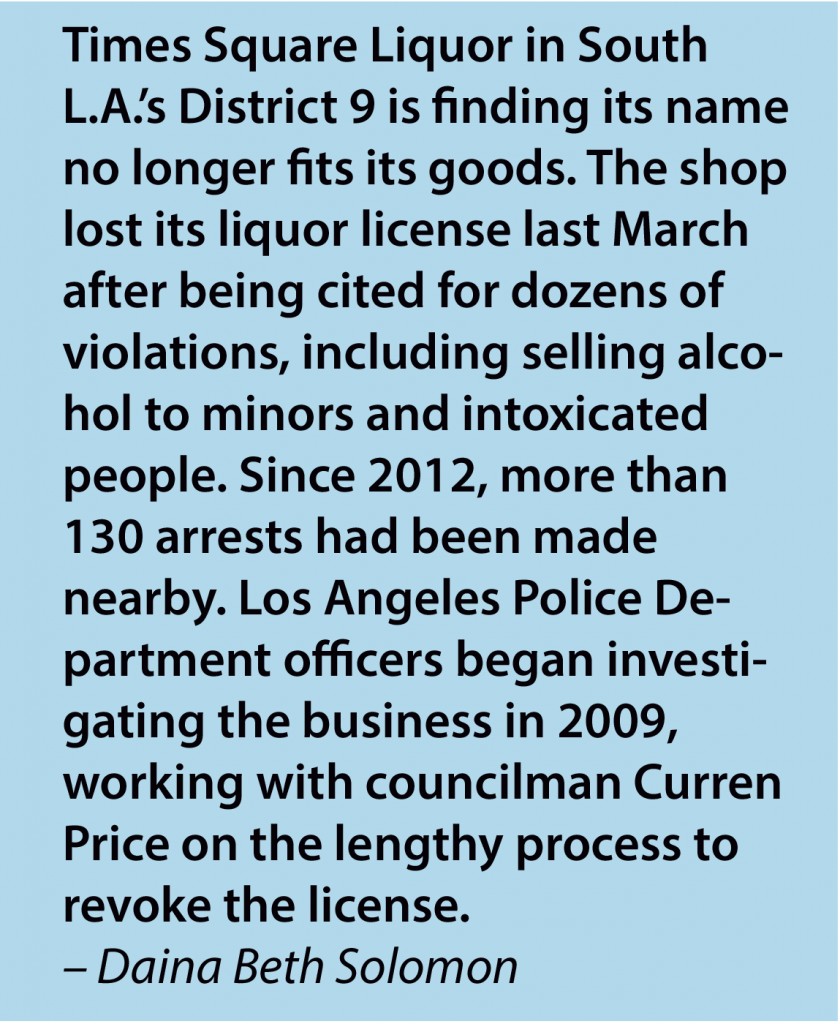On West 48th Street in Hyde Park, a neighborhood of South L.A., children soak in the afternoon sun on swing sets and plastic slides at Angeles Mesa Park. Just down the street, amid residential streets lined with quiet houses, Kenny’s Market & Liquor stands covered in bright yellow paint, its luminescent ‘liquor’ sign inviting passersby to peek inside.
According to the 2012 “Health Atlas” compiled by city and county departments, Kenny’s Market & Liquor is just one of 152 establishments with an off-sale liquor license in South L.A.
This license allows a person to purchase alcohol at the establishment and consume it off the premises. South L.A. has one of the highest numbers of off-sale licenses in Los Angeles.
Scattered throughout the area in residential and retail areas alike, liquor stores have become a staple of South Los Angeles’ economy and lifestyle.
See also: Century Liquor becomes Century Market, bringing freshness to South L.A.
In a study of 74 cities within Los Angeles County from the American Journal of Public Health in 1995, a higher density of alcohol outlets correlated with more acts of violence, regardless of socioeconomic standing and race of the perpetrators. In a separate study of the county from the Journal of Studies on Alcohol in 1994, an increase in alcohol-related motor vehicle crashes correlated with the number of liquor stores in the area.
For health professionals and academics engaged in the study of social issues, the detrimental impact of liquor stores on their neighboring communities is a continuing problem. Bridget Freisthler, associate professor at the department of social welfare at UCLA, has spent over a decade researching the effects of alcohol access on violence and alcoholism, and her findings have shown that more liquor stores create a harmful effect.
Using data from three counties in California, Freisthler compared the frequency of reports of child abuse and neglect with the density of alcohol outlets and found that a consistent correlation. When there was a rise in liquor store density, there was also a rise in child abuse and neglect or the other way around. Freisthler’s research on off-premise alcohol outlets and violent assaults in California showed a significant correlation as well between the number of liquor stores and perpetrators of assault.
“Places that have higher densities of outlets have increases in violence, child abuse and neglect [and] traffic crashes,” said Freisthler. “There’s quite a lot of different social problems that are related to the density of alcohol outlets.”
Learn about the history of South LA’s liquor stores — whose numbers are much fewer than they were 20 years ago:

Graphic by Daina Beth Solomon
The statistics in South L.A. appear to mirror Freisthler’s findings.
Between 2001 and 2010, an average of 7.5 car collisions involved alcohol in South L.A. per 10,000 residents — one of the highest rates in the county. In District 8, which includes West Adams and parts of South L.A., between 2006 to 2008 10.5 deaths per 100,000 residents were alcohol-related. In contrast, in District 5 –spanning the Westside and the San Fernando Valley, where liquor stores are fewer – had a rate of 4.3 per 100,000.
Many organizations in South L.A. are working to combat the high number of off-site alcohol outlets and ensure this high number does not increase.
 Community Coalition, or CoCo, an initiative spearheaded by U.S. Rep. Karen Bass (D), works to create safe and healthy neighborhoods. Part of this goal involves arduous efforts to “close or clean up liquor stores and nuisance businesses that contribute to the cycle of crime and addiction,” according to its website.
Community Coalition, or CoCo, an initiative spearheaded by U.S. Rep. Karen Bass (D), works to create safe and healthy neighborhoods. Part of this goal involves arduous efforts to “close or clean up liquor stores and nuisance businesses that contribute to the cycle of crime and addiction,” according to its website.
Through advocacy and lobbying, CoCo has made a positive impact in the community. In 2011, South L.A. liquor store Vermont Liquor was forced to close its doors after almost 20 years of community backlash, all of which was documented by CoCo. After the riots in 1992, which resulted in the destruction of hundreds of liquor stores, CoCo was able to prevent the city from rebuilding these alcohol-vending businesses by mobilizing residents to attend rallies and city hearings.
To aid the progress of local organizations, council districts in South L.A. are also making an effort to monitor and limit liquor outlets. For District 8, no outlet is considered for permit approvals unless it also sells groceries and other goods, said Councilman Bernard Park’s spokesperson, Kimberly Briggs.
“By having a responsible merchant [who] presents an opportunity for the community to satisfy all of its grocery and beverage needs, it may diminish the market share of any closely located liquor stores,” Briggs said.
Like Intersections on Facebook, follow us on Twitter and sign up for the Newsletter to stay in the loop on news and views from South L.A.
















Speak Your Mind